#6822
Explore tagged Tumblr posts
Text
#6822
Let a mind that is fragmented To be mutated Than get forever deleted.
1 note
·
View note
Text
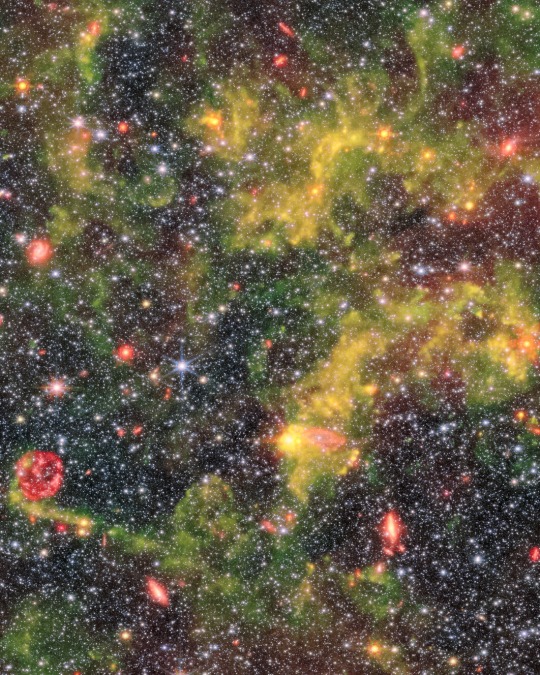
Gas-rich NGC 6822: Barnard's Galaxy © JWST
#galaxy#space#ngc 6822#astrophotography#stars#night sky#universe#solar system#nasa#jwst#webb#james webb space telescope#astronomy#planet#cosmos
606 notes
·
View notes
Text

Fandom Problem #6822:
When you hear someone accusing a story of queerbaiting but at this point in fandom you don't know if that means that there actually was queerbaiting or there was a popular mlm ship that didn't become canon and the fans are whining despite the fact that the story itself never tried to act like they were more than friends.
84 notes
·
View notes
Text



The life and times of dust, Galaxy NCG 6822
l ESA/Webb l MiRi l NiR+MiRi l NiR
#nasa#esa#webb#space#astrophotography#astronomy#ngc 6822#james webb telescope#stars#universe#solar system#planets#galaxy#sky
962 notes
·
View notes
Text
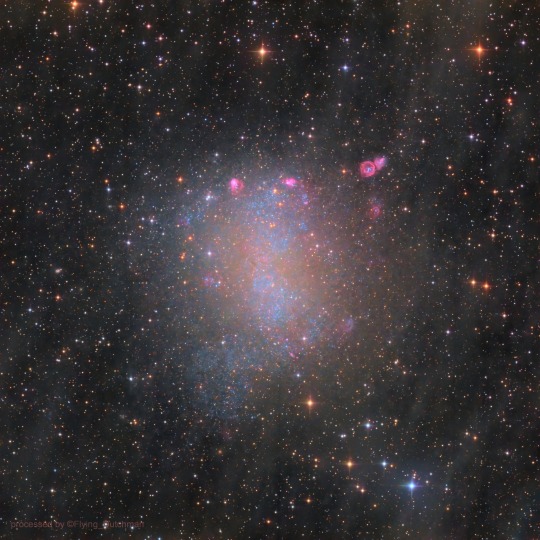
Barnard's Galaxy, C57 // Xinran Li
Observations of this galaxy shows over 150 star-forming regions. Most of the stars in this galaxy formed within the last 3 to 5 billion years. This might coincide with a flyby it made of the Milky Way about 3 to 4 billion years ago, although it has spent most of its life in relative isolation.
#astronomy#astrophotography#caldwell catalog#galaxy#irregular galaxy#star-forming galaxy#Barnard's Galaxy#NGC 6822#caldwell 57#C57#sagittarius
54 notes
·
View notes
Text

Supernova Ring and Ghost Galaxy
397 notes
·
View notes
Text

Galaxy NGC 6822 by Webb Telescope
The life and times of dust
This image shows the irregular galaxy NGC 6822, which was observed by the Near-InfraRed Camera (NIRCam) and Mid-InfraRed Instrument (MIRI) mounted on the NASA/ESA/CSA James Webb Space Telescope.
NGC 6822 lies about 1.5 million light-years away, and is the Milky Way’s nearest galactic neighbour that is not one of its satellites. It has a low metallicity, meaning that it contains low proportions of elements that are not hydrogen and helium. Metallicity is an absolutely key concept in astronomy, in part because elements other than hydrogen and helium are largely produced by stars over their lifetimes. Therefore, in the very early Universe (before the first generation of stars had been born, lived and died) everything had very low metallicity. This makes contemporary low-metallicity objects (like NGC 6822) objects of interest for understanding how processes such as the evolution of stars and the life cycle of interstellar dust likely occurred in the early Universe. This was the motivation for these observations of NGC 6822 with Webb: to better understand how stars form and how dust evolves in low-metallicity environments.
ESA/Webb, NASA & CSA, M. Meixner.

#Galaxy NGC 6822 by Webb Telescope#james webb telescope#james webb photos#james webb images#galaxy#galaxies#space#nasa#nasa picture of the day
44 notes
·
View notes
Text



ngc 6822
#jwst#james webb space telescope#ngc 6822#how tho#the universe is just crazy yo#irregular galaxy#barnards galaxy#sagittarius constellation#nircam#ic 4895
11 notes
·
View notes
Text
Karkat Vantas
Act 6, page 6821-6822
KARKAT: TEREZI...
KARKAT: NO
#homestuck#karkat vantas#homestuck act 6#page 6821#page 6822#homestuck act 6 act 6#homestuck act 6 act 6 intermission 2
0 notes
Text


Had to get some second hand parts for this one. I had chewed the rocket pieces too much on the originals, and the connection plate was bent on one of them.
0 notes
Text
First light from ESA's new Euclid space telescope with an ultra high-res, wide-angle lens to map the structures of the universe, helping astronomers study dark matter/energy.
Perseus Cluster of Galaxies

This Moon-sized patch of sky looks back ten billion light-years and shows about 100,000 galaxies, plus some stars from our own galaxy (points with diffraction spikes).
The cluster's Y shape reveals the gravitational influence of dark matter filaments, the web of the universe which until now was too big to fit in any telescope's view.
The Hidden Galaxy (IC 342)
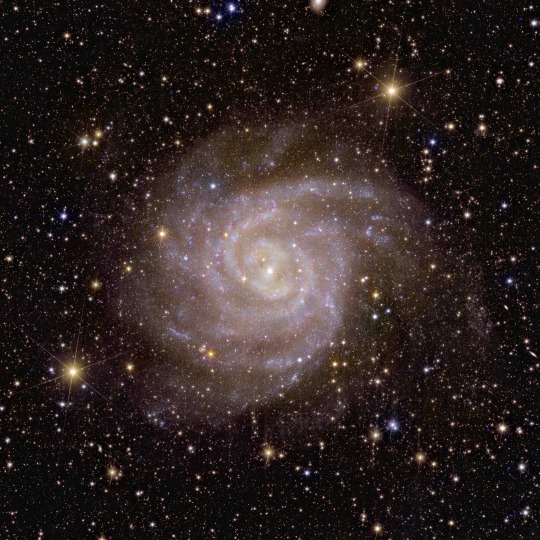
Euclid took only 5 hours to peer through the thickest part of our own galaxy edge-on and capture this galaxy hidden behind it.
Its spiral shape gives us an idea what the Milky Way would look like from above. The image is false color: red has been shifted towards blue so infrared can be shifted up to red we can see.
Irregular Dwarf Galaxy NGC 6822
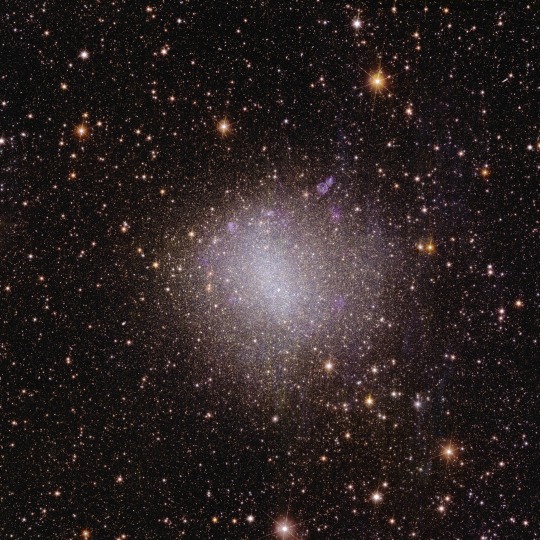
Just 1.6 million light-years from Earth, this little companion to the Milky Way is so close that until now it could only be captured in low res by ground telescopes or zoomed in to just one small part by Webb or Hubble.
It has a lot of old, low-metal, first-generation stars that can help astronomers study the universe's history.
Globular Star Cluster NGC 6397

It looks similar to a dwarf galaxy, but is much smaller and closer at just 7800 light-years away, and it's within the Milky Way. Perturbations of its outer stars in streaks and waves give clues about gravitational interactions within the Milky Way.
Again, other telescopes can't see the whole cluster in any detail, both because of its size and the high contrast between the bright center and faint outer stars, which would take Hubble hours to capture. Euclid imaged both in just an hour.
The Horsehead Nebula

This smear of dust lies in the larger star-forming region of the Orion Nebula just below Orion's belt. It's one of the most busy star nurseries in our vicinity, just 1375 light-years away.
Euclid's resolution is such that close study of this one-hour exposure should reveal many baby stars, brown dwarfs, and young Jupiter-mass planets.
234 notes
·
View notes
Text
NGC 6822 New image from James Webb Space Telescope

#james webb images#james webb photos#jwst images#jwst#astronomy#nasa#astronomers#universe#nasa photos#astrophotography#astrophysics#outer space#nasawebb#hubble space telescope#space travel#international space station#space science#space exploration#space#space shuttle#our universe#cosmos#planetary nebula#nebula#planetary science#nasa science#science facts#science#i love astronomy#astronomy facts
68 notes
·
View notes
Text
The Year’s Most Spectacular Photos from the James Webb Telescope
By Jeffrey Kluger
December 22, 2023

Close to 1,500 light years from Earth lie a pair of baby stellar twins known as Herbig-Haro 46/47 — which are barely a few thousand years old.
A star the size of our sun, by contrast, takes an average of 50 million years to reach even the stellar equivalent of young adulthood It's Herbig-Haro 46/47's extreme youth that gives the formation more of a blob-like appearance than the stellar duo it is.
Young stars are buried in clouds of dust and gas, which they absorb as they grow. Sometimes, however the infant stars ingest too much material too fast.
When that happens, dust and gas erupts from both sides of the formation, giving the young pair their misshapen look.
But if you have patience — 50 million years worth of patience — what is a blob today will be stars tomorrow.
NASA, ESA, CSA. Image Processing: Joseph DePasquale (STScI)
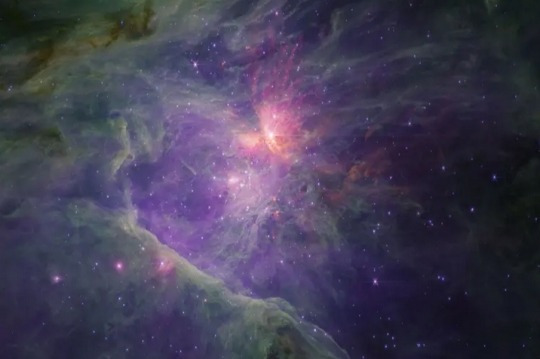
A pair of brilliant stellar nurseries located 1,600 light years from Earth, the Orion Nebula and Trapezium Cluster are home to a relative handful of very young but very bright stars.
Four of the stars are easy to see with a simple, amateur, four-inch telescope.
One of the four — the beast of the young litter — is especially visible, a full 20,000 times brighter than our sun.
Apart from their four main stars, the Orion Nebula and Trapezium cluster contain approximately 700 additional young stars at various stages of gestation.
NASA, ESA, CSA/Science leads and image processing: M. McCaughrean, S. Pearson, CC BY-SA 3.0 IGO

(L): It’s not easy being a Wolf-Rayet star, like this specimen imaged by the Webb telescope at a distance of 15,000 light years.
A rare species of stellar beast — NASA estimates there are only 220 of them in a Milky Way galaxy with at least 100 billion stars — the Wolf-Rayet burns hot and burns fast, with temperatures 20 to 40 times the surface of the sun.
All of that rapidly expended energy causes the star to lose its hydrogen envelope quickly and expose its helium core.
The result: a very early and very violent death.
A star like our sun burns for about 10 billion years. As for a Wolf-Rayet? Just a few hundred thousand before it dissolves into cosmic dust.
NASA, ESA, CSA, STScI, Webb ERO Production Team
(R): If the Wolf-Rayet star dies an ugly and violent death, the celebrated Ring Nebula, photographed by the Webb at a distance of 2,000 light years from Earth, has been expiring beautifully.
The glowing remains of a sun-like star, the nebula was discovered in 1779 by the French astronomer Antoine Darquier de Pellepoix.
As the nebula throws off its outer layers of ionized gas, it reveals its characteristic blue interior, composed of hydrogen and oxygen that have not yet been expelled off by the nebula’s stellar wind.
ESA/Webb, NASA, CSA, M. Barlow (University College London), N. Cox (ACRI-ST), R. Wesson (Cardiff University)
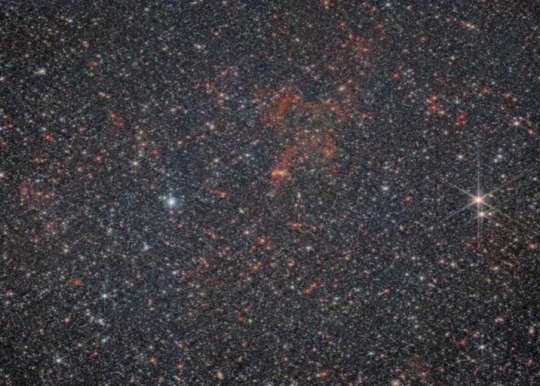
Dwarf galaxy NGC 6822 lives up to to its name — home to just 10 million stars, compared to the minimum of 100 billion in the Milky Way.
But what NGC 6822 lacks in numbers, it makes up in spectacle — which the keen eye of the Webb telescope has revealed.
Discovered in 1884 by American astronomer E.E Barnard, NGC 6822, is now known to have a prodigious dust tail measuring 200 light years across..
What's more, it's home to a dense flock of stars that glow 100,000 times brighter than our sun.
ESA/Webb, NASA & CSA, M. Meixnev

Spiral galaxies are often defined by uneven — and even ragged — arms.
But not galaxy M51, which lies 27 million light years from Earth and is defined by the tautness of its arms and the compactness of its structure.
M51 isn't alone in space. Nearby lies the companion galaxy NGC 5195.
The two galaxies are engaged in something of a gravitational tug of war — one that the NGC 5195 is winning.
NGC's constant gravitational pull is thought to account for both the tightly woven structure of M51's arms and for tidal forces that are thought lead to the creation of new stars in the arms.
ESA/Webb, NASA & CSA, A. Adamo (Stockholm University) and the FEAST JWST team
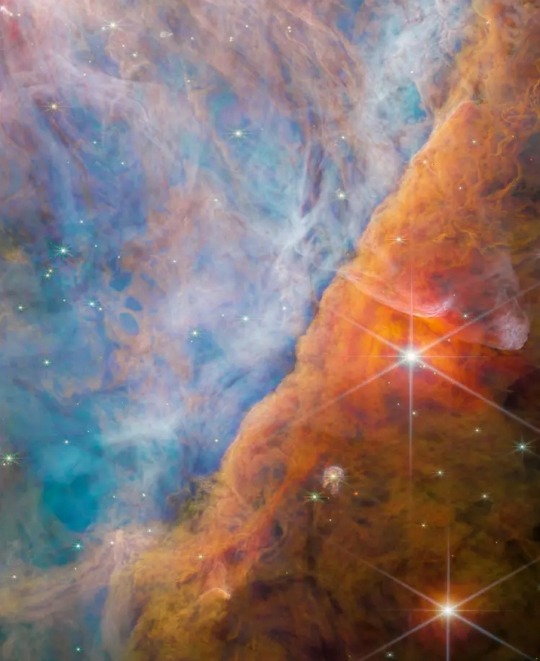
Just below Orion’s belt lies one of the most celebrated objects in the night sky: the Orion Nebula, a stellar nursery that is home to about 700 young stars.
This Webb image focuses not on the entirety of the nebula but on a structure in the lower left-hand quadrant known as the Orion Bar.
So named because of its diagonal, ridge-like appearance, the bar is shaped by the powerful radiation of the hot, young stars surrounding it.
ESA/Webb, NASA, CSA, M. Zamani (ESA/Webb), and the PDRs4All ERS Team

A baby by stellar standards, the IC 348 Star cluster is just five million years old and located about 1,000 light years from Earth.
Composed of an estimated 700 stars, IC 348 has a structure similar to wispy curtains, created by dust that reflects the light of the stars.
The conspicuous loop in the right hand side of the image is likely created by the gusting of solar winds blowing in the direction that, from Earth, would be west to east.
NASA, ESA, CSA, STScI, Kevin Luhman (PSU), Catarina Alves de Oliveira (ESA)
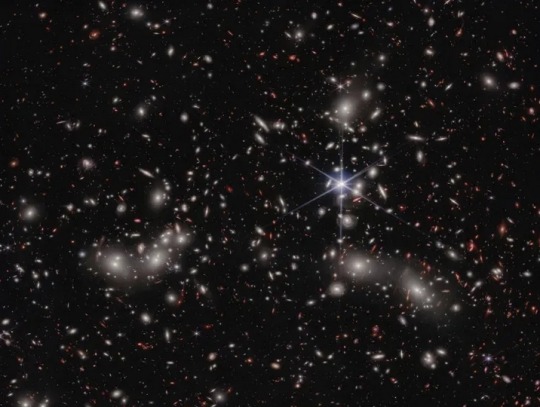
When it comes to galaxies, there's big and then there's huge and by any measure, Pandora's Cluster — more formally, known as Abell 2744 — qualifies as the latter.
Not just a galaxy, and not even a cluster of galaxies, Abell 2744 is a cluster of four clusters, which long ago collided with one another.
Located 3.5 billion light years from Earth, Pandora's Cluster measures a staggering 350 million years across.
The cluster's massive collective gravity allows astronomers to use it as a gravitational lens, bending and magnifying the light of foreground objects, making them easier to study.
NASA, ESA, CSA, I. Labbe (Swinburne University of Technology) and R. Bezanson (University of Pittsburgh). Image processing: Alyssa Pagan (STScI)

Webb was built principally to look at the oldest and most distant objects in the universe, some of 13.4 billion light years away.
But doesn't prevent the telescope from peering into its own back yard.
This image of Saturn and some of its 146 moons, rivals the images obtained by the Pioneer and Voyager probes.
NASA, ESA, CSA, STScI, Matt Tiscareno (SETI Institute), Matt Hedman (University of Idaho), Maryame El Moutamid (Cornell University), Mark Showalter (SETI Institute), Leigh Fletcher (University of Leicester), Heidi Hammel (AURA). Image processing: J. DePasquale (STScI)
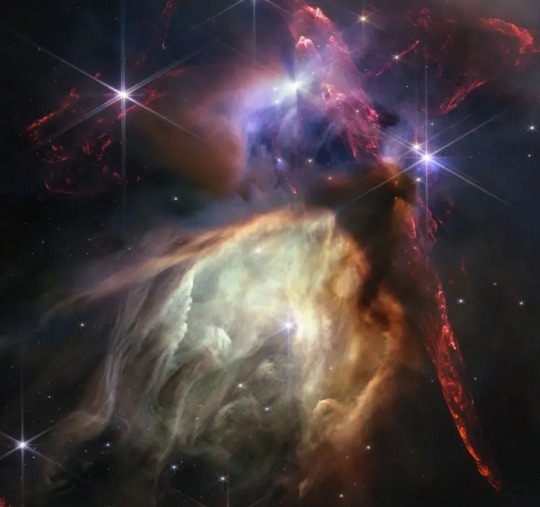
Infant stars are born all over the universe, but the closest stellar birthing suite to Earth is the Rho Ophiuchi cloud complex, located just 460 light years distant.
A turbulent — even violent — place, Rho Ophiuchi is defined by jets of gas roaring from young stars.
Most of the stars in this comparatively modest nursery are more or less the size of the sun.
But one, known as S1, is far bigger — so much so that it is self-immolating, carving a great cavity around itself with its stellar wind, the storm of charged particle's all stars emit, though few with the gale-force power of S1.
NASA, ESA, CSA, STScI, Klaus Pontoppidan (STScI)
#James Webb Telescope#James Webb Space Telescope#telescope#space#stars#galaxies#universe#cosmos#astronomy#space photography#photpgraphy#NASA#galactic clusters#milky way galaxy#Orion’s belt#Orion Nebula#Orion Bar#Pandora's Cluster#Saturn#Rho Ophiuchi cloud complex#Trapezium Cluster#Wolf-Rayet#Ring Nebula#Antoine Darquier de Pellepoix#E.E Barnard#spiral galaxy#nebula
114 notes
·
View notes
Photo

NGC 6822: Barnard s Galaxy
Credits: Dietmar Hager, Eric Benson
25 notes
·
View notes
Text
The Best of Both Worlds - Chapter Four
Din Djarin x Female Reader Modern!AU



❁ Series Masterlist ❁ My Masterlist ❁ Read on AO3 ❁

Word Count: 6822 Rating: General Summary: Despite his reservations and against his better instincts, Din heads to a Star Wars convention that he was invited to. Although he fears that his cover will be blown, curiosity gets the best of Din and he can't resist attending a panel. But Din doesn't exactly find the answers he was looking for. Instead, he finds something far more precious. Something that he would never have expected... Content Warnings: None! Author's Note: This was fun to write. Middle pic is one I took in a panel at SWC last year, just to set the scene. Din was down bad from minute one and honestly it's very cute to see him so flustered 🥺!! Also adorable how similar their experiences/reactions to the convention were! Anyway, hope you enjoyed! I can't wait to post the next chapter, hopefully coming on Sunday :) Thanks again @suresnips for being my beta! I appreciate your help so, so much ♡

4. Curiosity Killed The Cat (Din's POV)
To an observer with no background knowledge of Star Wars or its fandom, it would appear that most of The Mandalorian panel's attendees were merely a little bored. However, someone more familiar with the Star Wars world may have realised that the audience had been expecting something more profound. Maybe they had been hoping for some character analysis of the titular character or to participate in a larger discussion on how the show slotted into the wider Star Wars galaxy during this talk. After all, the panel was entitled: ‘The Man behind the Mandalorian: Exploring the Identity of the Galaxy’s Best Bounty Hunter.’
Instead, anyone who had sought out this panel surely would have found themselves bitterly disappointed, as the host had reduced The Mandalorian to nothing more than its violent action scenes. The host appeared to have a fixation on the fighting which occasionally took place in the show, at the expense of all other elements.
Perhaps that was the reason why the audience, on the whole, looked so incredibly bored. Even one attendee, wearing an almost unbelievably realistic cosplay, seemed more entertained by the seams of his gloves than anything the panel had to say about the show he was surely such a huge fan of. His helmet was bowed towards the floor as his leg bounced up and down repeatedly, a sure sign of his restlessness and his keenness for this panel to be over so he could continue his day at the convention.
To outside observers – whether they knew everything about Star Wars or nothing at all – the man dressed in full Mandalorian armour was possibly one of the biggest fans of the show. After all, he had replicated Mando's costume in painstaking detail; it must have taken an unbelievable amount of effort and hours, borne out of the intense love for The Mandalorian that he surely had.
But Din Djarin was not a cosplayer… his armour was not a costume.
The suit that he wore had not been crafted due to his undying love for Star Wars, it had been cast in Beskar, according to ancient traditions, at a forge by the golden-haired woman who served as The Armorer for his tribe.
It felt strange to Din for him to sit there and be spoken about as if he was not present. Of course, to everyone else in the room, the notion of Mando being in the room with them seemed as likely to happen as it was for pigs everywhere to spontaneously begin flying. To all other attendees, Din had just cosplayed as his favourite character. Everyone else in the room did not have the faintest idea that they were in fact in the presence of the man behind the character they all loved. While the assembled group enjoyed Mando enough that they had made their way to the far corner of the enormous convention hall for this panel, they didn’t know that sitting amongst them was the man who portrayed the Star Wars character that they loved so much. Nor that the armour that they had seen so many times on their screens was right there, beside them. Close enough to touch, if they wanted to.
The thought of being amongst so many super fans almost dissuaded Din from attending this panel, which had caught his eye. After deciding to attend the convention the previous evening, Din had used his laptop to search through the events for the day as he lounged on the couch in his cottage, Grogu playing on the rug beside him. This particular panel had instantly stuck out to him, above all others that were advertised. Din had always harboured a curiosity about what The Mandalorian meant to people. But it was perhaps a more selfish interest that had motivated him to seek out this panel in particular: Din wanted to know whether the fans had any idea about his identity.
Din had intended to sneak in and hover at the back and watch the panel from there before exiting as discreetly as he entered. But things had not gone according to that plan at all. Din had never attended an event as enormous as this and had no idea how it worked – he felt out of his depth. It was a feeling he was unused to and uncomfortable with, as Din always liked to be in control and have a plan.
Ironically, it was the very show which was being discussed that had first put cracks into his careful, considered nature. Relinquishing some of that control in signing up to be The Mandalorian had been difficult for Din, as he was required to be on set for a strict filming schedule in a brand new country. The stability and money that had been offered was something Din had struggled to refuse, especially given the fact he now had an extra mouth to feed.
But as Din sat there in the room where the panel was being held, he knew that coming here had all been one gigantic, terrible mistake. It was a stupid, nonsensical idea. It had been nothing more than a rush of blood to the head, Din just hoped he would be able to leave again having remained undetected. There was an old saying that Din had heard many times: ‘Curiosity killed the cat.’ Now, Din felt as though he finally understood that phrase.
Din was furious with himself that he had put himself in the position to hear such harsh words about the show after he had tried so hard to keep himself away from all of the attention portraying a lead role in a Star Wars show brought. For a man who was usually so calculating and meticulous in his actions, this had surely been the most foolish decision that Din had made in a long while.
Even worse than Din's decision to attend this panel, he mused, was his decision to attend the convention wearing his armour. Being surrounded by superfans made Din keenly aware that if any one of their gaze were to linger long enough, perhaps they would realise that his armour was not merely a highly impressive cosplay. So in a bid to distract himself and calm his racing heart, he began fiddling with the stitching of the tips of his mustard-coloured gloves. It was a sign of the acute anxiety that he was currently enduring, but to anyone watching, his fidgeting probably indicated sheer boredom.
Din mentally kicked himself for the ridiculous decision to attend the convention wearing his armour. The choice had made the entire event even more anxiety-inducing than it needed to be. Din lamented the fact that he could have come here with Grogu and simply blended in with the thousands of other families bringing their children to the convention for a fun-filled day. True, it would have still been an overwhelming experience and Grogu may have struggled with the crowds, but at least then, Din wouldn’t have had to constantly fear his identity being exposed when someone realised that his armour was a little too screen-realistic to be a simple cosplay.
Indeed, it was the skill and dedication of other fans that had initially eased Din’s fears of detection when he had walked into the crowded hall and began moving with the sea of people to an unknown destination up ahead. Even if he wanted to choose his path, there was no way to; Din was lost amongst the endless sea of people. As he travelled down the main hall, his mouth felt dry underneath the helmet and his heart thundered in his chest as he had no idea where he was going. But once he had made it to the side and stopped briefly to orient himself, Din realised just how many fans there were cosplaying as Mando.
Din had been stunned by the many amazing cosplays he had seen. After collecting his nerves, he slowly began to move down the hall and gave a polite nod of the head to any other Mando cosplayers he passed. Most returned the gesture, in shared acknowledgement of each other’s craftsmanship. Progress had been slow, though, as Din was constantly asked for photos. Even worse were those that did not ask, but merely threw themselves at him. Some even touched Din without asking first, a gesture which made him flinch. It annoyed Din, just because he was dressed in cosplay did not mean he gave consent to be touched whenever others pleased.
Despite the host of incredible cosplays he had passed, Din knew that none of them truly lived up to his armour, his was a cut above the rest. There was no way to perfectly replicate real Beskar, no matter the incredible lengths that some of the cosplayers had gone to. He just hoped that no one would question it too deeply.
After a few minutes of walking around the main hall, Din had decided he needed some respite from the endless photo requests and eyes that Din felt watching his every move. Din found a quiet corner of the hall with some near deserted toilets and headed for them. He sealed himself into the stall and removed his helmet, grimacing at the way his hair clung to his forehead thanks to how much he had perspired due to his nerves. The helmet was climate-controlled, so the heat of the building should not have been an issue. It could not legislate for Din's emotions, though.
Each time Din moved to leave, he found that the anxiety he had felt while walking through the hall reared its ugly head. He kept telling himself that he only needed a few more minutes to regain his composure. That was until Din checked his watch and realised it was not long until the panel began.
So Din had unintentionally spent most of the time before the panel hiding away in the toilet stall in an attempt to repair his shattered nerves. At that point, it would have been so easy for Din to leave. But he knew that the curious part of his mind would never forgive him if he did not at least check out the panel. It was perhaps the best opportunity he was going to get to discover what people thought of the show, whether they liked the character and, most importantly, whether they had any theories on who The Mandalorian was.
Yet, now he was actually sitting there in the panel, he cursed not only himself for not leaving earlier, but Din also cursed Peli Motto for giving him such a stupid idea to attend this convention in the first place.
Many times throughout the panel – which was headed by a man called Jeff who wore a backwards baseball cap, despite looking as though he should have grown out of such a fashion choice several decades ago – Din had considered getting up and walking out. He had arrived pretty late as it was, only a minute or two before it began, as he hoped to sneak in and take an unassuming spot at the back. But the seats had all been filled back there, and an overly enthusiastic volunteer had guided him to a spare aisle seat about fifteen rows back from the front.
Luckily, almost everyone had been too wrapped up in watching Jeff and his cronies fumble around with technology to pay him much mind, except for the people on his row who were in awe of his ‘cosplay.’ It would have been so easy for Din to just up and leave since he was on the end of the aisle. But he was fearful that it would have drawn too much attention to him. Thus far, he had pretty much gone undetected. Jeff had not bothered to look at the audience too clearly to notice the incredibly realistic Mandalorian that was currently in the room with him. Which was unsurprising, given how self-centred the man appeared to be. The panel really ought to have been retitled ‘The Jeff Show.’
Most of the panel had been pretty inoffensive, if a little dull. Din silently objected to the way that Jeff had reduced the show down to only its violent components, rather than engaging with it on a deeper level. At times, Jeff was so close to understanding what the action scenes demonstrated about Mando’s character and the wider politics of the galaxy. But then he would just make another crass comment about how good Mando was at killing and all progress would grind to a halt.
But then Jeff opened up the floor and invited the audience to step forward to the mic so he could hear comments from the fans. Din leaned forward in his seat, excited to finally fulfil the purpose of attending this panel and hear what others thought of the show that he had poured so much of his heart and soul into. But if Din was expecting to hear positive feedback, he was about to be bitterly disappointed.
Frustratingly, most speakers took their opportunity to address the audience to do nothing more than complain about never seeing Mando’s face or knowing his name. It was no surprise to Din that people felt that way, even if he was a little disappointed that people were so fixated on those two elements. Din knew it had been a concern at the beginning of the show, during early production meetings. But thanks to some input from Din himself, the character of Mando now felt more fleshed-out than he had when Din had joined the project.
Plus, Din felt as though viewers could understand enough about the character and his intentions without needing to know his name or see his face. It was a belief that was being challenged by the attitudes of the attendees of this panel. But Din was not too upset. After all, he was more concerned with whether any fans had any viable theories about his identity. Mercifully, none of them appeared to have picked up on any rumours. When the show's creators told him that no one suspected that Din Djarin was The Mandalorian, it appeared they had been telling the truth.
Fortunately, despite the name of the panel, there had been no speculation on Mando's true identity thus far. Despite the panel's title hinting that the man behind the Mandalorian would be discussed, that had so far not transpired. Things appeared to be looking up for Din; not only had there been no speculation as to his identity, but none of the audience had noticed the incredibly realistic cosplay that was sitting amongst them.
That was until a young man with brown hair, dressed in a Mando t-shirt and jeans stood up and moved towards the mic. His comments started positively enough, “I mean, don’t get me wrong, I love the show and all,” The man confessed, and Din smiled slightly underneath the helmet. However, he continued: “But I just feel like we don’t know that much about Mando. It’s as if we, as an audience, are being held back from connecting with him fully because of some diva’s selfish demands to keep his identity hidden!” The man exclaimed.
Din felt his blood run cold. He swallowed thickly, feeling bile rise in his throat. He should have known that this was a bad idea, that coming here was a mistake. But the man was not quite finished, yet:
“Seriously, the guy who plays him must be such an asshole. Imagine having to work with that guy!” He ended his tirade, to a smattering of laughter and applause from the room.
The accusations that he had thrown Din’s way, about him being an asshole or a diva – a charge that in particular made no sense, as surely a diva would want their name and face to be plastered everywhere – had been like a punch to the gut. And Din had endured many of them throughout his life to understand exactly how painful they could be.
Far from the kind words he had been expecting, instead, Din had been forced to listen to various people slander both the show and him as a person. Din’s heart ached as he heard the charges being levelled against him; it was one thing to criticise the show but to call his character into question caused a whole other level of pain. If they only knew why he had to keep his identity a secret, they would never throw such cruel accusations his way.
Din wasn’t naive. He knew that by signing up for a Star Wars show, his life would change forever. It was not a decision that he had taken lightly. Especially given that his way of life was opposed to everything the mega-corporation that now owned Star Wars stood for. But it presented an opportunity to not only secure a consistent income and better life for himself and his son but also to showcase his culture to the world. It was an opportunity that Din really could not turn down. However, just because Din was prepared for his life to change in some ways did not mean that he could ever be prepared to be attacked on such a personal level.
At that moment, Din almost tossed aside his priority to remain hidden and not draw attention to himself as he debated walking out of the panel. After hearing such personal attacks against his character, Din was so close to just upping and leaving that room. He had heard enough. If there was even one more vaguely harsh word tossed Din’s way, it might have tipped him over the edge.
Despite the tough exterior that Din Djarin projected to the rest of the world, he was at his core, a fairly sensitive man. He knew that the things that he had already heard about himself would take him a long time to come to terms with. He couldn’t bear to hear any further unkindness.
Din planted his feet firmly on the floor and began to lean forward, preparing himself to leave. It seemed that in a war between his mind and body, his body had won… his subconscious was going to make him stand up and storm out of that room, against all rational thought.
In all of his anguish, Din had missed the girl who had stormed forward to the microphone, dodging limbs and hurdling bags, to stand before the room.
But then she began speaking and her presence became impossible to ignore any longer; her voice was shaky with nerves but there was absolute conviction and certainty behind every word.
And Din was frozen to the spot, utterly transfixed. Suddenly all thoughts of leaving exited his mind.
“I think tying Mando’s identity to his name and face is a pretty narrow way of viewing how we can understand who someone truly is inside and what exactly motivates them. I mean, I think I’ve connected to his character pretty well without ever seeing his face or knowing his real name. That’s because Mando has proved time and time again what kind of man he is,” The girl argued and Din found himself instantly relaxing and leaning back in his seat. “The way he has risked his life multiple times to rid the galaxy of threats and evil shows that he is committed to securing a brighter future, even if he is not around to see it. This man is willing to sacrifice himself for the greater good. Sure, we don’t know his name or face or a lot about his origins, but I think to us, that should prove that he has nothing but noble intentions. That human side of the man beneath all of the armour allows us to connect to him on a far deeper level than just seeing a face and learning a name ever could,” She finished and Din shut his eyes and took a deep, steadying breath. Unbeknownst to her, the kind words she spoke had soothed Din's soul. She had begun to heal the wounds that were opened by the previous speakers' harsh words.
Din noticed how nervous the girl seemed and the way she fiddled with her hands as she stood at the microphone. He marvelled at the way she had been up like a shot to defend the character, though. Plus, judging by how eloquently she spoke, Din assumed she was used to this.
Din sat there and listened with a small smile on his face, shaking his head slightly in awe as she launched into a passionate defence of the character. Unlike all previous speakers, the girl understood just as Din did, that seeing someone’s true intentions and the qualities they possessed mattered more than knowing their name or what they looked like.
Suddenly, Din began to feel a lot lighter. People did care, people did love and appreciate the show and they understood Mando as a character. He was pleased by that fact. Din knew he would stay now. Even if the next speakers reverted to being less than complimentary, the girl had bolstered his confidence and soothed his bruised ego enough to stick around.
Din expected that the girl would retreat to her seat after giving her opinion. The awful man who ran the panel certainly seemed to think that was the case as he met her passionate speech with empty platitudes, which Din thought bordered on the patronising.
However, what she did next caused Din’s jaw to drop beneath his helmet. The girl did not return to her seat. Instead, she spoke up and continued to defend not only the character of Mando but also the man behind him.
Din listened in awe as she started speaking up to defend the man who was, unbeknownst to her, sitting only a few feet away.
“Also, I know no one outside this room will probably ever hear what had been said at this panel, but I think attacking the character of the man who portrays Mando, simply because he wants privacy, is unfair. I think we should always talk about people, online and publicly, as though they can read or hear what we say,” She argued and Din almost snorted at that assertion.. if only she knew that he was right here. “We don’t know why he won’t say who he is, but I trust that he has his reasons. Even then, he doesn’t need to have a good reason. Everyone is entitled to their privacy for the simple fact of wanting to be private,” The girl appealed to her fellow fans. Din felt tears pool in his eyes at her beautiful sentiment. Until she came along, he had been about to leave, with his last memories of the panel, believing that everyone hated him and thought he made the show worse. Now, though, he was listening to a passionate, eloquent defence of his character.
The girl finished off her speech with a comment about the show. She explained how Mando respected everyone that he encountered in the galaxy and left the places he visited better than he found them. She implored her fellow fans to take the same lessons from the show, rather than focus on the violent, action scenes. When she was finished, Din wanted to stand up and applaud her, before rushing up to her and thanking her from the bottom of his heart.
It was clear that she understood exactly what The Mandalorian was truly about. The show was, at its core, about respecting others and learning to peacefully coexist. Mando was fighting for a better galaxy, a kinder galaxy and once people understood that, they would understand how important it was to respect the actor behind the Mandalorian.
Din had an overwhelming urge to make his way over to this stranger, to thank her from the bottom of his heart for standing up for Mando so passionately. He knew, given his cosplay, that he could easily pass as an enthusiastic fan.
Then Din remembered who he was and settled on the upsetting reality that he couldn’t take such a reckless action.
If he spoke, she might recognise that the voice beneath the helmet was the very same one that she had no doubt seen on screen so many times. It was too great a risk and, much as Din would have loved to thank her, it now seemed as though their paths would diverge without her ever knowing how truly thankful Din was for her words and how much they had done to boost his confidence. Ultimately, although it was sad, Din knew that it was how things had to be. The risk was too great.
Although for the short time remaining that Din would remain in her orbit, Din was determined to commit every inch of her to memory, so that he would never forget the woman who had unknowingly done so much to him. Din was determined to impress her on his memory on the off-chance that their paths would one day cross in a scenario where he might be able to get to know her. After all, Din was a man, and he was not immune to the fact that she was a beautiful woman, perhaps several years younger than him. But her beauty was not just skin-deep; it was to be found in the way she spoke so eloquently. How she addressed the room with such maturity and wisdom. To Din, it appeared as though she had lived several lifetimes.
Now she had sat back in her seat, Din could only appreciate the back of her profile, though he had noticed the cute slope of her nose and her plush lips as she made her way back to her seat. Din focused on her hair. It looked so soft that he wondered how it would feel against his skin as he nuzzled into her scalp and pressed a soft kiss of gratitude there.
The T-visor had its perks, as no one else in the room was any the wiser to how intently Din had affixed his gaze to her, much like Mando did when tracking a bounty. Din found that, even if he had wanted to, he could not look away from her. He watched quietly as her friend whispered excitedly to her. She was only a couple of rows in front of him and was almost close enough to reach out and touch.
Perhaps that was how Din could make her feel his appreciation in a low-risk way, through a simple touch. He wondered whether he could put his hand on her shoulder on the way out and convey his thanks with a nod of his helmet the way Mando would. But that was another fantasy that would not come to pass, as Din knew that when this panel was reaching its conclusion, he had to make straight for the doors before he got swamped by any of the enthusiastic fans in here. He had seen the way throughout the panel that the number of people who had spotted his incredible ‘costume’ had increased. Din knew he was drawing many eyes.
Despite the overwhelming urge inside him to thank the girl, Din knew that he had to keep moving through the convention centre. Cutting a dedicated path, scything his way through the crowd like the methodic warrior he was.
So, when Jeff started wrapping up the panel, Din sprang straight to his feet and strode towards the doors, before a single soul could say anything. There were a few excited faces and murmured gasps as he strode purposefully towards the exit, but fortunately, no one was quick enough to stand up and thwart his quick exit.
Bizarrely, even though he was unused to being around so many people and had initially found the experience overwhelming, Din found that after the panel, he felt far more comfortable in the larger, crowded spaces at the convention. In a small room, there was no privacy. Anyone and everyone could look at him, their steely, judgmental eyes burrowing into him. They know… he had been constantly thinking to himself throughout the panel. But of course, no one was any the wiser to his true identity. Even if the panel's attendees thought that the costume was realistic, the idea of the real Mandalorian attending a convention dressed as himself was too far-fetched to be real. Even the most imaginative fanfic writer could not come up with such a ridiculous plot.
So, Din found himself physically relaxing as he made his way back to the main hallway. His shoulders were less tense, his jaw unclenched. After he left the panel, Din had not intended to linger much longer. But as he found himself wandering around, stopping for more and more photos with eager fans who were so blown away by his ‘cosplay,' Din discovered that he began to almost enjoy the attention.
There were so many children here too. Some were not much older than Grogu. Din wished he had brought Grogu with him, but he knew that the convention would not have been a welcome environment for his precious son, especially given his nervous disposition. But Din knew with absolute certainty that Grogu was having a pleasant afternoon, he was being looked after by an elderly man named Kuiil, who was a babysitter that the studio had initially put him in touch with. Kuiil was always dependable and happy to help Din out whenever he needed him to take care of Grogu, no matter how little notice Din gave.
Din was gradually growing in confidence as he strode through the main hall of the convention centre. Now, when fans asked for photos or even launched themselves at him without asking first, Din found that he was less nervous. To every request, Din just nodded. When people thanked him, although they didn’t always – Din occasionally wished he could speak to remind them to mind their manners – Din made the same gesture. A simple nod said so much, without saying anything at all.
Din would never speak while wearing his armour. To most, it perhaps came across as an incredible amount of dedication to cosplaying the character – Mando, after all, was a man of few words. But the reality was that Din knew his voice could blow his cover.
Ordinarily, Din rarely feared his voice would give him away as The Mandalorian, as his Mando voice was distorted somewhat by the helmet, so the difference was sufficient enough for Din to feel confident that no one would realise he was Mando. But surrounded by superfans at this convention, in the very helmet that would distort his voice to make him unmistakably sound the same as Mando, Din deemed it far too great a risk to take.
After stopping for photos and fistbumps with enthusiastic fans of all ages, Din was finally ready to make his exit, much later than he believed he would have initially. Ultimately, Din was glad he had attended the panel and not rushed off earlier in the day when he had felt so overwhelmed that he had been driven to hide in the toilet. Although the panel had not been an entirely positive experience, it had been worth it just because of her.
And to think, Din was so hurt after the comments some fans had made about him at the panel that he would have missed out on feeling all the love and appreciation for Mando, had it not been for that girl who took a stand and raised her voice in defence of him. Her words had allowed DIn to feel lighter, freer and as though he wanted to open himself up to the love the fans were prepared to show him.
The day at the convention had been an amazing, eye-opening experience. One that was far out of Din’s comfort zone, something that he never would have believed he could do for himself. But now he realised that he had also stayed far longer than he had been expecting. Din wanted to get back to his son. Grogu was usually settled and happy for the first few hours, but Din knew that it would soon begin to veer into the territory where a meltdown may be more likely.
Plus, Din had finally had enough for the day. He was accustomed to wearing his armour for long periods – it was like a second skin, after all – but he hadn’t sat down, nor removed his helmet for hours. Despite his increased confidence, the fear of being discovered lingered. The fear that his ‘costume’ would be sussed out set him constantly on edge and was draining him far more than a heavy suit of armour could.
So Din began making his way to the exit through the expansive main hallway. He almost made it through without stopping, until he noticed a massive banner with a photograph of himself on it. Din stopped for a second, looking up at it as he remembered the day that photo had been taken. It had been a nerve-wracking experience for him, he was certainly not a model, but they had needed some promo shots. So Din found himself there, posing awkwardly in front of a professional photographer who was barking orders at him and wondering when arms and hands had become such awkward, cumbersome things. Din would rather have spent an entire day throwing himself into walls without a single break before repeating the experience and had informed The Mandalorian's creative team as much. So future photoshoots were completed with a body double wearing a copy of Din’s armour. The photo on display was one of the few that was him, though.
Din stood there for a few moments, smiling proudly at it underneath his helmet before a small voice caused Din to stop reminiscing over the gigantic poster and abruptly turn on the spot to face the direction of the voice.
“Excuse me, could we take a photo with you, please?” A timid voice said. In response, Din felt every hair stand on end as he instantly recognised the person who the voice belonged to.
It was the girl from the panel, staring at him with absolute admiration and adoration. He stood open-mouthed and gawked at her for a few seconds, stunned to be in her presence once again. But then her beautiful features changed. She frowned slightly and then Din realised he had been standing there, frozen, as he stared at her in disbelief. She had taken his silence and inaction as a dismissal and almost retreated before Din snapped out of his trance and nodded quickly. He wanted to tell her how wonderful she had been at the panel, how much her words had meant to him. But everything happened so fast.
Din felt his heart rate quicken as the girl moved to stand next to him. Her arms hung by her side somewhat awkwardly, just like Din’s had in the photo on the poster that he had just been admiring. She was too nervous - or perhaps polite - to sling one around his shoulder or waist. Din wouldn’t have minded though, there was something imperceptible about her that made Din want to be drawn into her orbit. She had a magnetic presence.
Din barely remembered to turn and look up at the girl’s friend who was taking the photo, his ordinarily calm and composed mind had been catapulted off its axis by her presence. The girl went to step away, but Din raised a hand just in front of her body to stop her from moving off.
“Wait, let me… pose properly,” Din choked out, forgetting his vow of silence in a moment of recklessness. He held his breath for a few seconds, but if she recognised his voice, she did not acknowledge it. Din released a shaky breath, trying not to be frustrated with himself. After all, Din had only good intentions. Out of everyone he had taken photos with today, she deserved the best out of them all.
“Oh, thank you!” The girl laughed and smiled appreciatively as she took her place back by Din’s side.
Din placed one hand on his belt and leaned in towards her, hoping that the picture turned out to her satisfaction. They stood there side by side, almost close enough to touch. At that moment, Din wanted nothing more than to remove his helmet and bare his face to the alluring woman who had publicly spoken so eloquently in his defence and been equally polite in their more private encounter. But even if he had wanted to, they were out of time. Their few seconds together were over.
“Thank you! Your cosplay is amazing, by the way! It looks so realistic!” She said with a shy smile as she stepped away. “I think there’s a cosplay competition at the Twin Suns stage this afternoon, you should seriously consider entering. I’m sure you’d win!” The girl said encouragingly.
Din nodded stiffly, struck by her manners and how genuinely excited and encouraging towards others she seemed to be. Both traits mattered deeply to Din. But there were also nerves behind his suddenly restricted motions as he once again feared his cover being blown. Din supposed that it would be unsurprising if it was the same girl from the panel who had shown such a passion for the character was finally the one to connect the dots.
Despite the momentary panic caused by her comment about how realistic his costume was, Din was still amazed by how sweet she had been. The way her eyes shone with genuine excitement as she approached him and yet, she managed to maintain that respect for him that other attendees did not. So many people rushed up to Din when he was in this costume, without even stopping to ask his permission for a photo, let alone take a second to look at him or politely thank him. The fact she had thanked him and complimented him and even spoken encouraging words about his cosplay proved to Din that she was one of the politest attendees.
Din had a few more seconds to appreciate being in the girl’s presence as the friend she was with stepped up to have a picture with him. The girl’s friend seemed more confident than her in the way she posed, she seemed to know exactly what to do. But Din was paying her no mind. Instead, he glanced at the details of her face he could see from behind the phone – complete with Mando case – that she was using to take the photo. Din noticed the spark in her eyes, the way they lit up when she looked at him. She probably didn’t realise just how much Din could see in the helmet and that he was staring directly at her, noticing the look of awe she wore on her face.
“Thank you,” The girl’s friend said with a polite nod and the two walked off.
Din stood for a moment, watching them as they went. They flicked through the photos, jumping up and down excitedly as they looked at one. They were just out of earshot, but Din could tell how excited they both seemed by the pictures they had taken together. He smiled beneath his helmet. Knowing that he could bring such joy to others was a phenomenon he had lived in blissful ignorance of for most of the time since he had been cast as The Mandalorian, the only exception being when he had visited that children’s hospital a few months previously.
Today had opened Din Djarin’s eyes to the impact he was having out there, on so many different people. It was a debt that he owed to her, a debt that he knew he would, regrettably, never be able to repay.
Perhaps, in another reality, Din would have run after her, stopped her and confessed how appreciative he was of her kindness. He would have told her that he wanted to get to know her and asked her on a date if she was single. Maybe she would have been momentarily taken aback, given the bizarre circumstances of him wearing a full suit of armour and running up to her at a convention like that. But hopefully, she would have given him a chance.
They would have gotten to know each other, and gradually fallen in love over the next few months. Perhaps, if things went well, they would have lived a long and happy life together. It felt so real, for one fleeting moment, that Din could almost see their future together.
But that was ridiculous. In this reality, Din watched from behind his helmet as the outline of the girl he felt himself so drawn to grew smaller and smaller before eventually being swallowed up by the crowd.
She disappeared into the distance. Out of view, and out of Din’s life.
Next Chapter
Taglist: @toxic-seduction
#my fics#tbobw#din djarin fanfic#din djarin x reader#din djarin x you#the mandalorian x reader#din djarin fanfiction#mando x reader#mando x you#the mandalorian fanfiction#pedro pascal characters
40 notes
·
View notes
